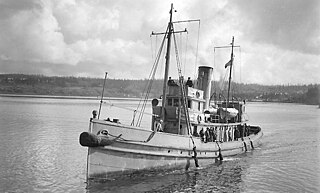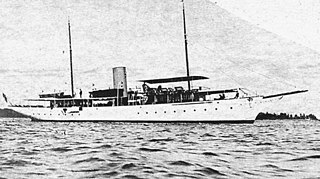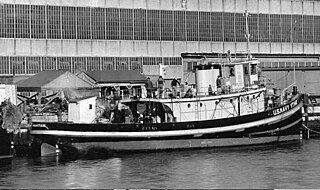USS Concord may refer to:

USS Challenge (SP-1015/AT-59/YT-126/YTM-126) was a commercial tugboat acquired by the United States Navy for service in World War I, and remained available for duty during World War II.
USS Alloway (YT-170/YTM-170) was an Alloway-class tugboat acquired by the U.S. Navy for the task of providing yard tugboat services during World War II, when U.S. ports were often congested with ships arriving and departing.

USS Penobscot (SP-982/YT-42/YTB-42) was a commercial harbor tugboat purchased by the U.S. Navy at the start of World War I. Penobscot performed her towing services for the 5th Naval District on the U.S. East Coast, and continued to do so for the 3rd Naval District through the end of World War II. She was finally retired from Navy service in 1947.

USS Lyndonia (SP-734), later known as USS Vega (SP-734) was a yacht acquired by the U.S. Navy during World War I. She was assigned as an armed patrol craft, but, at times, performed other duties along the U.S. East Coast, such as dispatch boat and training ship for the U.S. Naval Academy. Post-war, she was disposed of through sale to the public.
The first USS Barnegat (SP-1232) was a commercial tugboat acquired by the U.S. Navy during World War I. She was armed with a 3-inch gun and sent to Brest, France, to perform towing services for Allied ships. Post-war, she returned to the United States, was decommissioned, and was subsequently used on the Delaware River by the U.S. Army Corps of Engineers.
USS Arapaho (AT-14/YT-121) was an Arapaho-class fleet tug that performed various tugboat services for the United States Navy. She was constructed in Seattle, Washington; however, she spent most of her working career on the U.S. East Coast, primarily at Norfolk, Virginia, and Philadelphia, Pennsylvania.

USS Wahtah (YT-140), later YTB-140, was a United States Navy harbor tug in commission from 1939 to 1946.

The second USS Wando, later YT-17, later YT-123, later YTB-123, was a United States Navy tug in commission from 1917 to 1946.
USS Evea (YT-458), originally the sixth USS Resolute (YT-458), later YTB-458, was a United States Navy tug in commission from 1943 to 1944.

The second USS Uncas was a United States Navy tug in commission from 1898 to 1922.

The second USS Pocomoke (SP-265), later YT-43, was a United States Navy minesweeper and tug commissioned in 1917 and sold in 1922.

The first USS Tillamook, later AT-16, later YT-122, later YTM-122, was a United States Navy tug in service from 1914 to 1947.

USS Dreadnaught (ID-1951), later YT-534 and YNG-21, was a United States Navy tug that was in service from 1918 to 1944.

The first USS Chemung (AT-18/YT-124) was launched 1 April 1916 by Norfolk Navy Yard as Pocahontas and commissioned 14 March 1917. She reported to the 5th Naval District.
USS Wingina (YTB-395) is a tugboat that was laid down as District Harbor Tug YT-395. She was re-classified while still under construction as District Harbor Tug, Large YTB-395. After her commissioning, she served in the United States Navy from 1944 to 1980.

USS Active was a tug constructed in 1888 at San Francisco by the Union Iron Works. The tug, first steel tug built on the West Coast, was launched 4 August 1888. She was acquired by the United States Navy from John D. Spreckels Brothers Co. on 18 April 1898 "for auxiliary purposes incident to a state of war." Converted for naval service at her builder's yard, she was commissioned at the Mare Island Navy Yard on 6 July 1898. She was the third US Navy ship to be named Active.
Modoc was a steam tug, built in 1890 as the commercial tug Enterprise, in service with the United States Navy from 1898 to 1947. The tug had been assigned the hull number YT‑16 in 1920. When the name Modoc was cancelled 5 October 1942 the tug became the unnamed YT‑16 until reclassified in 1944 to become YTL-16. The tug served for 49 years and in both World War I and World War II before being transferred to the Maritime Commission in early 1947 for disposal.

The Type V ship is a United States Maritime Commission (MARCOM) designation for World War II tugboats. Type V was used in World War II, Korean War and the Vietnam War. Type V ships were used to move ships and barges. Type V tugboats were made of either steel or wood hulls. There were four types of tugboats ordered for World War II. The largest type V design was the sea worthy 186-foot (57 m) long steel hull, V4-M-A1. The V4-M-A1 design was used by a number of manufacturers; a total of 49 were built. A smaller steel hull tugboat was the 94-foot (29 m) V2-ME-A1; 26 were built. The largest wooden hull was the 148-foot (45 m) V3-S-AH2, of which 14 were built. The smaller wooden hull was the 58-foot (18 m) V2-M-AL1, which 35 were built. Most V2-M-AL1 tugboats were sent to England for the war efforts under the lend-lease act. The Type V tugs served across the globe during World War II including: Pacific War, European theatre and in the United States. SS Farallon and other Type V tugs were used to help built Normandy ports, including Mulberry harbour, on D-Day, June 6, 1944 and made nine round trips to Normandy to deliver Phoenix breakwaters.












